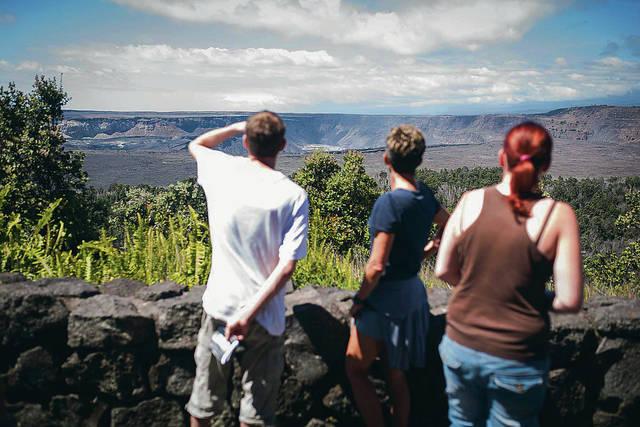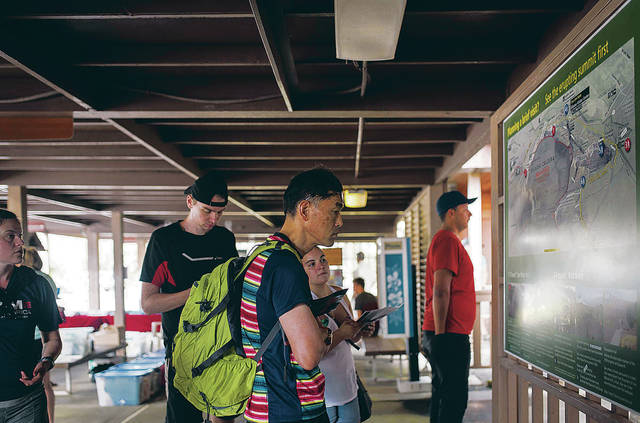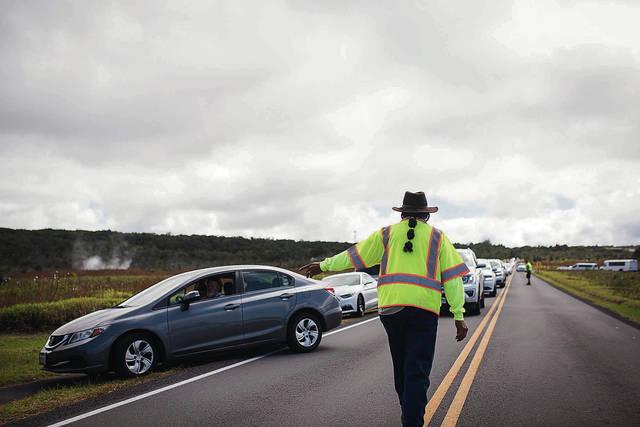VOLCANO >> Hawai‘i Volcanoes National Park, the premier visitor attraction for Hawaii island, reopened Saturday and welcomed an eager stream of tourists and locals from across the state.
There is no longer any molten lava to be seen within the park, and the trademark Jaggar Museum is closed indefinitely because of earthquake damage, but the parking lot was jammed at the Kilauea Visitor Center within hours of the 7 a.m. opening.
Parked cars lined Crater Rim Drive as hundreds of people hiked to a crater overlook near the park’s steam vents, and park rangers fanned out across open areas or patrolled on horseback. Visitors and longtime residents lined the rock wall to the rear of the Volcano House to stare into the summit caldera.
Kimberly Calderon, a Lanai resident who traveled to Hawaii island from Lanai to attend her son’s football game, was among the first to peer into the crater after the park opened. She heard rumors the park would open at 7 a.m., so she drove from Hilo with her daughter Summer- Lokelani Bicoy-Giles, 9.
Calderon had been to the summit when she was a sixth-grader on a field trip, “but it’s so different,” she said. “It’s like it just caved in, totally caved in. It looks like a bulldozer came in and dug it out. It’s amazing, it still has steam coming out.”
HAWAII‘I VOLCANOES NATIONAL PARK
>> Hours: Open 24 hours a day.
>> What to bring: Snacks, plenty of drinking water and a full tank of gas.
>> Some of what’s open: Kilauea Visitor Center and restrooms; Park Association bookstore; Volcano House partially open; Crater Rim Drive partially open; and Kilauea Iki Overlook and parking lot.
The eruption forced most of the park to shut down on May 11 and remain closed for 134 days as magma drained out of a reservoir under the summit to later emerge from fissures in Leilani Estates about 20 miles away.
The lava that flowed into the lower East Rift Zone destroyed more than 700 homes and covered more than 6,000 acres of land, but also caused profound changes at the park.
Rock formations within Halemaumau Crater and the caldera collapsed into spaces left vacant as magma flowed out. The crater floor, which had been 280 feet deep, is now as much as 1,700 feet deep.
Park spokeswoman Jessica Ferracane was part of an incident command team in the park that worked to respond to the emergency, and “we didn’t know what was happening,” she said.
“To sit in the emergency operations center with my fellow rangers and feel the building shake and see things break around me was astonishing,” she said. “We just weren’t expecting that. We were expecting … a big, giant gas ash explosion and then it would be over and we’d all come back to work.”
Instead, the series of earthquakes caused by collapsing material on the floor of Kilauea caldera shook the park and the Volcano Village area for months. There were 62 “massive collapse explosions,” according to the park service, and the eruption activity did not taper off until the first week of August. The last “collapse explosion” occurred on Aug. 2.
The tens of thousands of earthquakes that were part of the eruption caused what may be millions of dollars in damage to facilities in the sprawling park, Ferracane said. The park service says the damage to park infrastructure was “unprecedented in the park’s 102-year history.”
It included cracked water lines that cut off water service to portions of the park, and damage to many buildings including the U.S. Geological Survey’s Hawaiian Volcano Observatory building and Jaggar Museum.
Crater Rim Drive near the Kilauea Military Camp developed “huge sinkholes” that are still growing, although there is little seismic activity now, Ferracane said. Hilina Pali Road was also damaged, and “it’s not going to reopen anytime soon.” Cracks opened on Chain of Craters Road as well as sinkholes alongside the road, but it is still passable, she said.
The famous Thurston Lava Tube known as Nahuku is closed pending further assessments to look for damage.
Ferracane said there is no estimate yet of how much it will cost to repair all the damage to the park.
Diana Gula, 40, said she felt many of those earthquakes at her home in the Royal Hawaiian Estates subdivision in Upper Puna, but nothing broke, and she said she actually liked them. The shaking occurred every couple of minutes at times, and “it was exciting,” she said.
But the closure of the national park was a loss. Gula often hiked there, and she and her son Joshua joined the stream of people entering the park Saturday as soon as it reopened.
“It’s just because we’re excited to see all the changes, and to be back here again,” she said, standing at the caldera lookout near the steam vents. “It’s a lot bigger. I think it’s even prettier now.”
The park attracted more than 2 million visitors last year or about 5,500 each day, and appeared likely to top that daily attendance total on Saturday. Park officials recommend that visitors bring snacks, plenty of drinking water and a full tank of gas.
Saturday was National Public Lands Day, and the theme for the day was resilience and restoration, which Ferracane thought was appropriate. The park soon will announce opportunities for volunteers to assist with recovery efforts and begin recruitment.
“Thanks everybody so much for being here today,” Ferracane said. “We really missed you. We missed being being in our home at Hawai‘i Volcanoes, and welcome back.”








